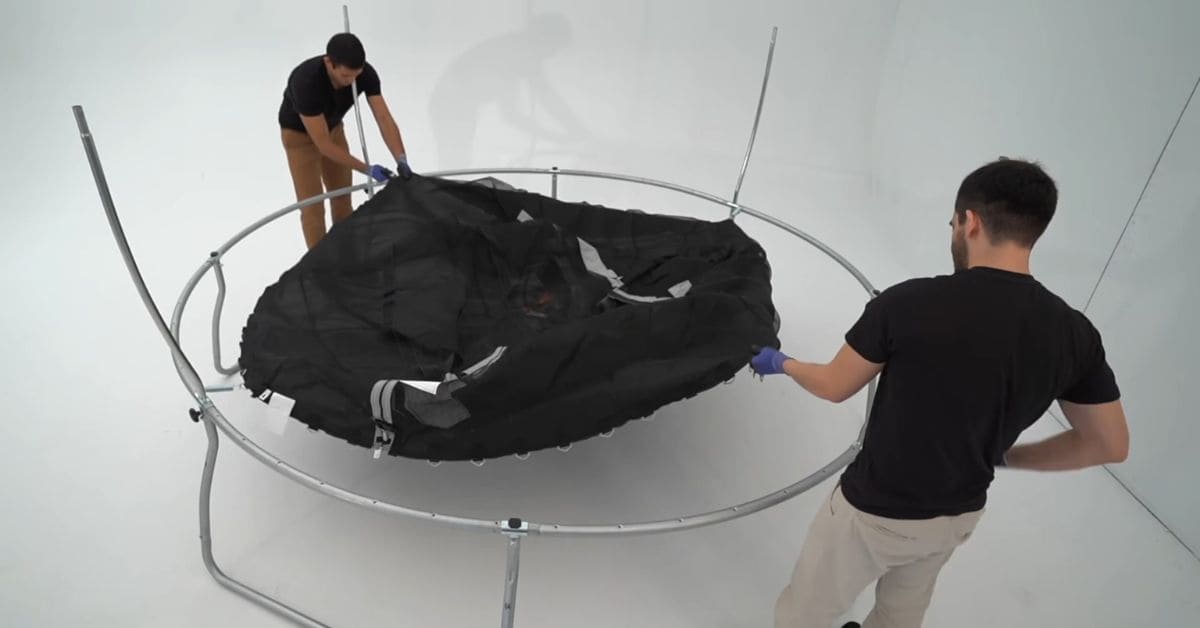Do you know how to pack a trampoline for moving? Proper packing is crucial when moving a trampoline to ensure safety. Start by gathering supplies like bubble wrap, foam padding, tape, zip ties, and sturdy boxes.
Remove the safety net, padding, and jumping mat, then disassemble the frame and springs, organizing and labeling them. Clean and maintain the components, and wrap the frame and springs in bubble wrap or foam padding.
Fold and pack the jumping mat, disassemble the safety net, and pack the padding securely. Use labeled boxes or containers and fill empty spaces to prevent shifting.
Secure the trampoline during transportation and consider weather conditions. Unpack and reassemble it at the new location, following the manufacturer’s instructions and inspecting for any issues. Proper packing ensures a safe and enjoyable trampoline experience after the move.
How to Pack a Trampoline for Moving: To pack a trampoline for moving, start by considering a replacement, then clear and clean it. Next, dismantle the trampoline and pack its parts in labeled boxes for easy transport.
How to Pack a Trampoline for Moving? Step-by-Step Guide
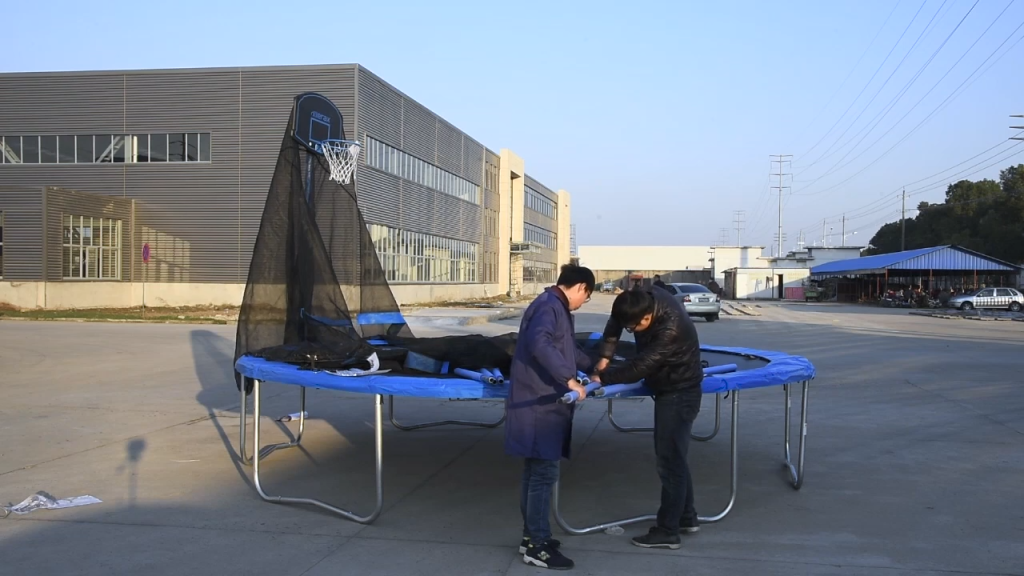
Here step by step guide for how to pack a trampoline for moving:
Exploring Replacement Options:
Before going through the trouble of moving your trampoline, it’s worth considering if it’s even worth it. Moving a trampoline can be time-consuming and expensive, so sometimes, buying a new one is easier and more cost-effective after you’ve moved.
If you haven’t properly maintained your trampoline, it may have experienced issues like rust, weakening, bending, tearing, or ripping. Take a moment to think about whether these problems will survive the move and if they will require replacement when you set it up again.
Investing in a new trampoline might be better if the damage is significant or there’s a risk of instability due to rusted parts. Remember, unstable trampolines can lead to unexpected injuries.
Clearing and Cleaning for a Move:
Suppose you’re confident that your trampoline will survive the move; cleaning it before packing is important. Trampolines accumulate leaves, cobwebs, bugs, and other debris from the garden, so you must eliminate them.
Start by sweeping off any garden debris. Then, use a household cleaner or a mixture of white vinegar and baking soda to clean stubborn marks and stains on the mat and padding.
Avoid using washing powder as it can stain the pads. If your trampoline has some rust, you can try removing it with a rust remover or a miracle cleaning paste.
However, this is only recommended for recent rust. If your trampoline is extensively corroded, it’s best to replace the affected part or consider purchasing a new trampoline.
Step-by-Step Dismantling for Easy Moving:
To dismantle the trampoline, start by undoing all the ties underneath it. Then, remove and fold the padded edge. Next, remove the poles and untie the net, ensuring you replace the bolt to avoid losing it.
Release the springs from the trampoline while keeping the net attached to the elastics. If you have a spring tool or puller with your trampoline, use it to install or release the springs.
Unscrew the top screws on the frame and remove the legs, applying some grease if needed to loosen them. It’s worth noting that dismantling the trampoline can save you money in the long run.
However, if you don’t have much distance to cover or have a vehicle large enough to transport an assembled trampoline, you can consider moving it without taking it down.
Labeled Boxes for Trampoline Parts:
As you disassemble the trampoline, pack all its parts in labeled boxes. A standard cardboard box will work, but ensure no metal pieces are next to the net and padding to prevent damage.
For small nuts, screws, and bolts, it’s a good idea to place them in labeled Ziploc bags to prevent them from getting lost in larger boxes. To aid in reassembly, taking photos of your trampoline, including its underside, is recommended before dismantling.
These photos will serve as a helpful reference to remember which part goes where when you’re ready to reassemble the trampoline.
Can a trampoline fit in the back of a truck?
Yes, a trampoline can typically fit in the back of a truck. Disassembling a trampoline allows easy removal and reduces the space it occupies during transportation. By taking apart the trampoline, you can dismantle the frame, remove the springs, and detach the jumping mat, safety net, and padding.
These components can then be neatly packed and arranged in the back of a truck, optimizing the use of space. Ensuring the trampoline parts are securely fastened and properly protected is important to prevent any damage during transit.
By carefully organizing and packing the disassembled trampoline, you can efficiently use the available space in the truck, allowing for safe and convenient transportation to your desired location.
Can a disassembled trampoline fit in a car?
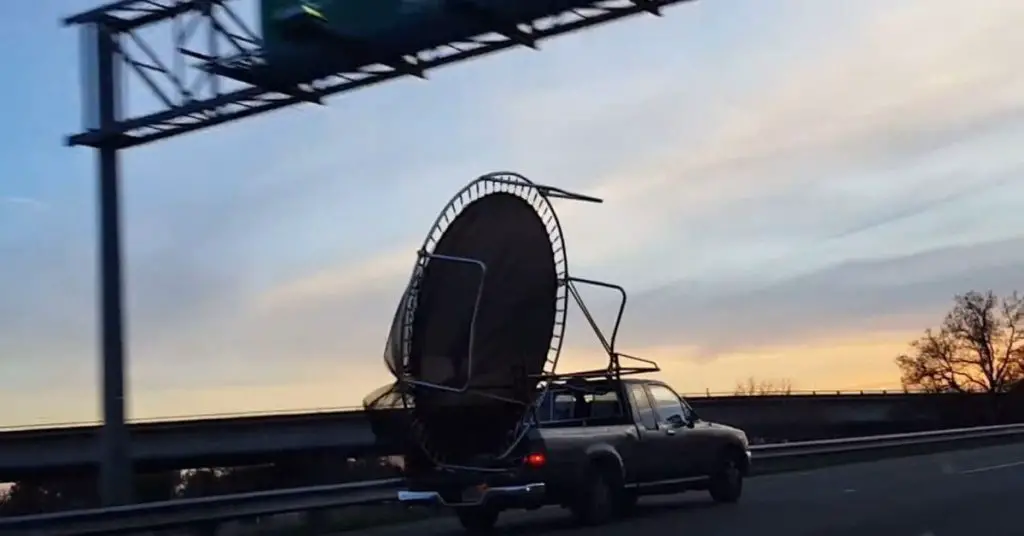
To determine if a disassembled trampoline will fit in your car, truck, or moving van, measure the dimensions of the trampoline when it’s taken apart. Typically, trampolines are designed to be easily disassembled, so they usually don’t require a lot of space.
By measuring the dimensions of the disassembled trampoline, you can determine if it will fit comfortably in your vehicle for transportation.
Is it possible to fit a trampoline inside a car?
Yes, it is possible to fit a trampoline inside a car. If you have a small trampoline, it can be folded down and placed in the back of a car. However, larger trampolines measuring 12ft or more typically need to be disassembled and packed into 3-4 boxes.
These trampolines can also be long, up to 8ft long. To transport these larger trampolines, you may need a vehicle like an SUV, minivan, or something larger that can accommodate the size and weight of the trampoline.
Disassembling a Trampoline for Easy Moving
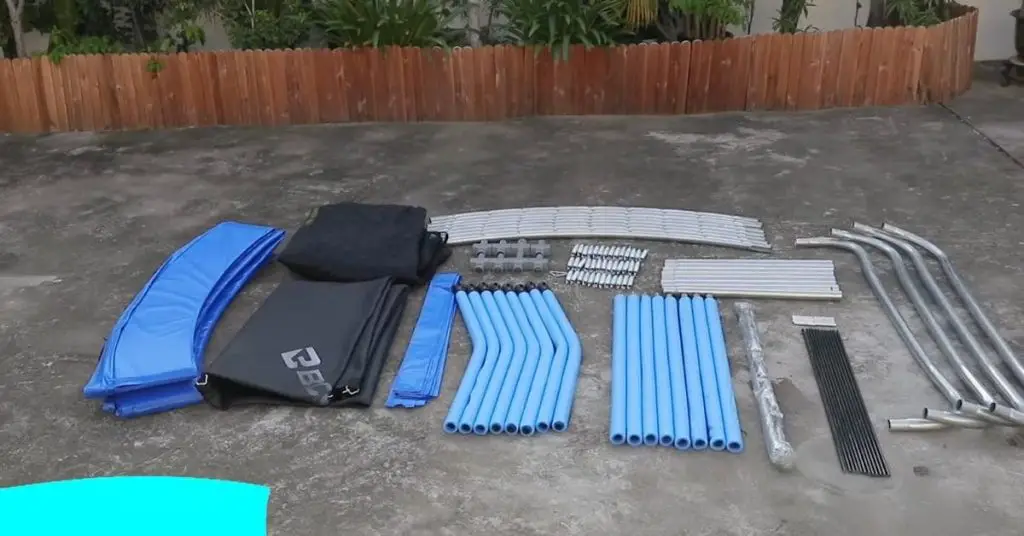
To move a trampoline safely, it’s best to take it apart. However, not all trampolines are easy to disassemble. Some may require special tools, while others can be dismantled more easily. Generally, you can follow these steps to take apart a trampoline:
- Remove the safety enclosure around the trampoline. This allows better access to the different parts and makes disassembling easier.
- Take off the padding that covers the trampoline’s frame. You might need a screwdriver or similar tool to remove any fasteners holding it in place.
- Unscrew or unbolt the legs from the main frame. You may need a wrench or socket set for this step. Once the legs are removed, you can fold up the main frame for transportation.
- Lastly, remove any remaining springs from the frame and pack them away.
By following these steps, you can safely disassemble a trampoline for moving.
Is it possible to move a trampoline without disassembling it?
Moving a trampoline without disassembling it is not possible or practical. Moving a trampoline without taking it apart is not cost-effective unless you are moving a very short distance, like to a nearby town or city.
Renting a trailer to transport an assembled trampoline over long distances can be expensive and may not leave enough space to transport other items. It is generally recommended to disassemble the trampoline for easier and more cost-efficient transportation.
Is it possible to fold a trampoline in half?

Yes, it is possible to fold a trampoline in half. Here’s how you can do it: Start by laying the trampoline mat on the ground. Then, fold the mat in half once. After that, fold the round end of the mat in half again.
If the mat is still too large, you can fold it in half again to create a long strip. Folding the trampoline in half allows for easier transportation or storage.
Can a trampoline fit inside a U-Haul truck?
Yes, a trampoline can fit inside a U-Haul truck. When the trampoline is disassembled, it becomes compatible with various types of vehicles, such as cars, trucks, and vans for transportation. Trampolines are designed to be easily removed and taken apart.
However, it is important to note that disassembling and reassembling a trampoline can be time-consuming.
What did you need to know about moving a trampoline yourself?
If you have a small trampoline, you can move it on your own. To do this, position yourself beneath the trampoline and use your back to push against the netting.
Lift the trampoline slowly and carefully until you can move it where you want it. Be cautious to avoid any injuries while moving it.
Is it possible to add wheels to a trampoline?
Yes, it is possible to add wheels to a trampoline. Springfree offers shifting wheels that make moving a trampoline easier. These wheels allow a single adult to move the trampoline for yard work or when you want to change its location. The package includes two pairs of wheel frames that can be conveniently placed under the trampoline’s frame legs.
Is it possible for one person to assemble a trampoline alone?

While one person can assemble a trampoline alone, having two people for the task is recommended. Trampolines are big and hard to handle, so putting one together alone can be challenging and unsafe. Having a second person to assist will make the process easier and safer.
What are the steps to move a trampoline that has wheels?
To move a trampoline with wheels, start by attaching the wheels to the legs of the trampoline. Then, drag the trampoline to the desired location. You can do this by yourself or with the help of someone else. Once you have completed the move, handling and transporting the trampoline will be much easier.
Gathering the Necessary Supplies
You’ll need a few key items to ensure a smooth and safe process when gathering the necessary supplies for packing a trampoline. Here are the supplies you should gather:
List of required supplies:
- Bubble wrap or foam padding
- Packing tape
- Zip ties
- Sturdy boxes or containers
- Markers or labels for labeling boxes
- Plastic storage bags for small parts
- Tools (e.g., wrench, screwdriver) for disassembly
Where to obtain packing materials:
- Hardware stores: You can find bubble wrap, foam padding, packing tape, and various box sizes.
- Moving supply stores specializing in packing materials may have specific trampoline packing kits.
- Online retailers: Many websites offer a wide range of packing supplies and can deliver them to your doorstep.
Quantity estimation based on trampoline size:
- Measure the dimensions of your trampoline and estimate the amount of bubble wrap or foam padding needed to cover the frame and springs.
- Estimate the number of boxes required based on the size and number of trampoline components.
- Consider having extra packing tape, zip ties, and plastic bags on hand for securing and organizing smaller parts.
Remember to prioritize the safety and protection of the trampoline components during the packing process.
Cleaning and Maintenance
Moving your trampoline is not only about packing and unpacking but also about maintaining it in good condition. Here are some tips for cleaning and maintenance:
- Cleaning the frame, springs, and jumping mat: Before packing, clean the trampoline frame, springs, and jumping mat thoroughly with soap and water. Make sure to remove any dirt, debris, or rust.
- Inspecting for any damages: Inspect your trampoline for any damages, such as a bent frame, torn mat, or damaged springs. If you find any issues, you need to repair or replace them before packing.
- Repairing or replacing worn-out parts: Replace worn-out parts such as springs, frame pads, or mats if necessary. Make sure to use high-quality replacement parts for optimal performance.
- Lubricating the springs (if necessary): If your trampoline springs are squeaking or making noise, apply a lubricant such as WD-40 to the springs to reduce friction.
- Ensuring proper drying before packing: After cleaning your trampoline, dry it thoroughly before packing to prevent mold or mildew growth. You can leave it in the sun for a few hours to dry completely.
Following these maintenance tips ensures that your trampoline is in good condition for your next move.
Packing the Trampoline Components
Once you have cleaned and maintained your trampoline, it’s time to pack its components carefully. Follow these steps to ensure safe and organized packing:
Wrapping the Frame and Springs:
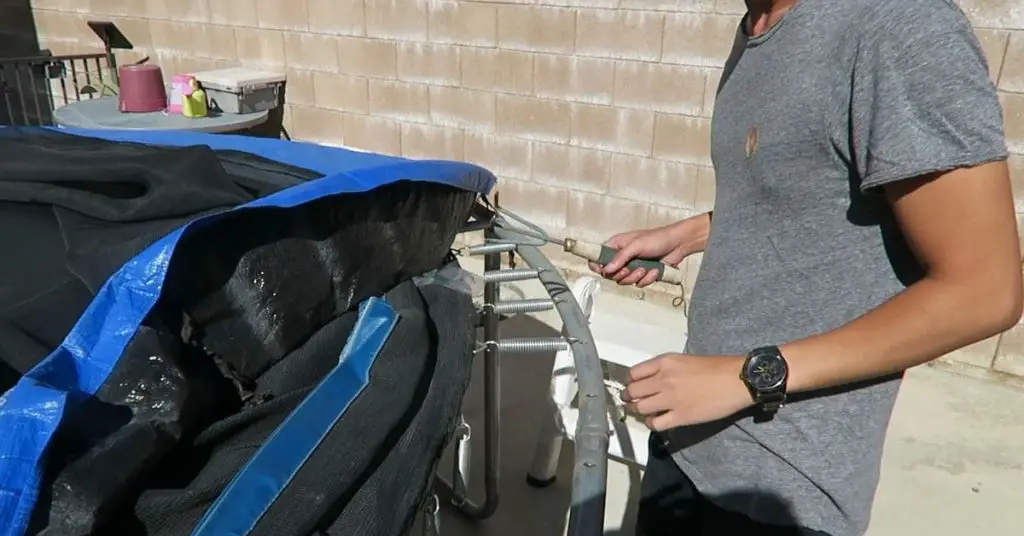
- Use bubble wrap or foam padding to protect the frame and springs.
- Wrap the frame and secure it tightly using tape or zip ties to prevent movement or damage.
Folding and Packing the Jumping Mat:
- Fold the jumping mat according to the shape and size of your trampoline. Refer to the manufacturer’s instructions if needed.
- Place the folded jumping mat in a storage bag or wrap it with heavy-duty plastic to protect it during transportation.
Packing the Safety Net and Padding:
- Disassemble the safety net, carefully folding it to avoid tangles or snags.
- Pack the safety net and padding securely, ensuring they are tightly wrapped or placed in a suitable container to prevent any damage.
- By following these steps, you can ensure that your trampoline components are packed safely and will be ready for reassembly at your new location.
Securing and Labelling the Packed Components
To ensure the safe transportation of your trampoline components and easy identification during unpacking, follow these steps:
- Choose appropriate boxes or containers to pack your trampoline components in.
- Place the packed components organized inside the boxes or containers, ensuring no space is left.
- Use packing materials such as bubble wrap, foam padding, or packing peanuts to fill empty spaces and ensure the components do not move during transportation.
- Label each box or container with the contents inside, including the specific trampoline parts and special handling instructions. This will help make it easier to identify and handle each box with care during transportation.
Reassembling the Trampoline
Here are some things for reassembling the trampoline:
Identifying and Organizing Packed Components:
Before starting the reassembly process, carefully identify and organize all the packed components. Check that you have all the necessary parts, including the frame, springs, jumping mat, safety net, and padding. Having a clear inventory will ensure a smoother reassembly.
Setting up the Trampoline in the New Location:
Choose a suitable location for the trampoline in the new area. Ensure the ground is level and free from any obstacles that could pose a safety hazard.
Clear the area of debris or objects that may interfere with the trampoline’s setup. Position the trampoline in the desired spot, ensuring enough space around it for safe usage.
Following Manufacturer Instructions for Reassembly:
Consult the manufacturer’s instructions or user manual for specific guidelines on reassembling your trampoline model. Follow the step-by-step instructions carefully to ensure correct assembly.
Pay attention to any specific instructions regarding the sequence of attaching components, tightening bolts, or adjusting tension.
Installing Safety Net and Padding:

Attach the safety net to the designated hooks or poles surrounding the trampoline. Make sure it is securely fastened and properly tensioned to provide a safe enclosure.
Install the padding or spring covers onto the frame, ensuring that they are evenly distributed and securely attached. This will help protect users from accidental contact with the springs or frame.
Performing Necessary Inspections Before Use:
Before allowing anyone to use the trampoline, perform a thorough inspection to ensure everything is in proper working order. Check the frame for any signs of damage or wear.
Examine the springs, jumping mat, and safety net for any tears, rips, or loose connections. Make any necessary repairs or replacements before allowing use to ensure the trampoline is safe for enjoyment.
FAQs:
Q1: Can I pack a trampoline for moving without taking it apart?
It is recommended to disassemble the trampoline before moving it. Taking it apart makes it easier to transport and reduces the risk of damage.
Q2: What supplies do I need to pack a trampoline?
You will need bubble wrap or foam padding for the frame and springs, tape or zip ties to secure the wrapped components, boxes or containers for storage, and labels for proper identification.
Q3: How do I fold and pack the jumping mat?
Fold the jumping mat based on the shape of your trampoline. Use a storage bag or heavy-duty plastic wrap to protect it during transit.
Q4: How should I pack the safety net and padding?
Disassemble and fold the safety net carefully, securing it with ties or tape. Pack the padding securely, ensuring it is well-protected from any potential damage.
Q5: How do I secure and label the packed components?
Choose appropriate boxes or containers that fit the components snugly. Use packing materials like peanuts or bubble wrap to fill empty spaces. Label each box with its contents and handling instructions for easy identification.
Q6: How do I reassemble the trampoline after moving?
Identify and organize the packed components, following the manufacturer’s instructions for reassembly. Set up the trampoline in the desired location, install the safety net and padding, and perform necessary inspections before use.
Q7: Is it necessary to perform any maintenance or inspections after moving the trampoline?
Yes, inspecting the trampoline for any damage or wear after it has been moved is essential. Check the frame, springs, jumping mat, safety net, and padding for any signs of damage or defects. Make any necessary repairs or replacements before allowing anyone to use the trampoline.
Conclusion:
In conclusion, packing a trampoline for moving is a task that requires careful planning and attention to detail. Following the steps, you can ensure your trampoline is properly protected and ready for transportation.
Start by considering whether it’s worth moving the trampoline or if it’s better to purchase a new one at your destination. Clear and clean the trampoline, removing debris and addressing rust or damage.
Dismantle the trampoline, carefully removing the parts and keeping them organized. Pack the components in labeled boxes, using appropriate padding and securing them to prevent damage during transit.
Finally, when it comes time to reassemble the trampoline, follow the manufacturer’s instructions to ensure it is set up correctly and safely.
After reading this comprehensive article, we hope you will be well aware of how to pack a trampoline for moving. If you have any questions, feel free to comment below!

